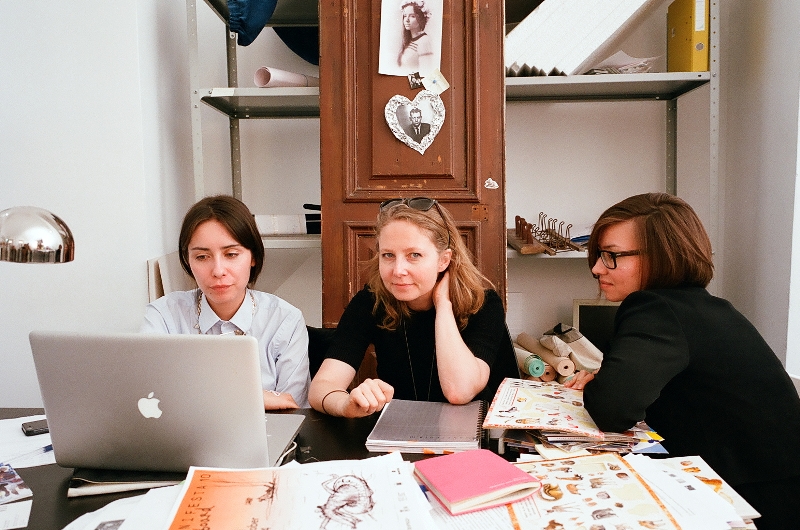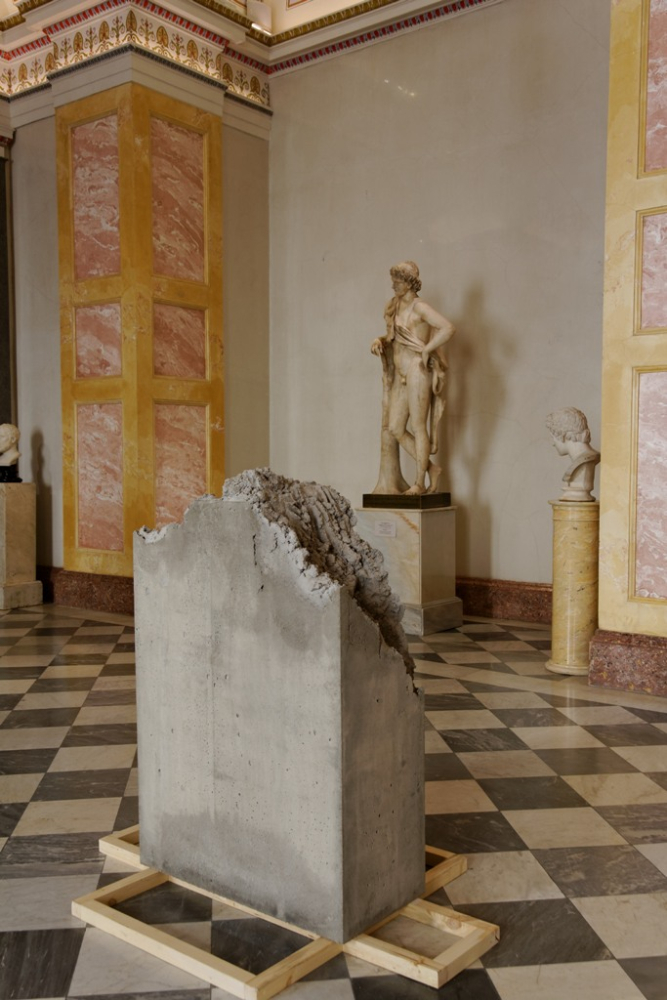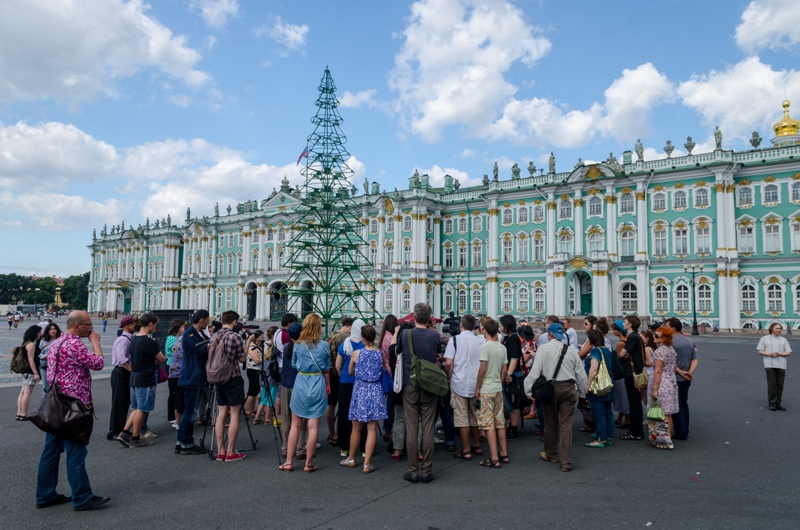Joanna Warsza introduces the Public Programme she curates at the Manifesta Bienalle. Not only in the context of the Bienalle, but also issues another statement in her Facebook explaining the reason to stay after annexation of Crimea: “We are confronted with the old political dilemma: engagement or disengagement? As much as we, of course, clearly and without doubt oppose the Russian military intervention in Crimea and the position of the Russian government, we also oppose the tone of westocentric superiority… The projects will obviously not represent the position of the Russian government. I believe that as long as we can work in the complex manner and in the context-responsive way, as long as we—curator, artists, team—are not exposed to self-censorship, not intimidated or restricted, we will do so.”
In June, before a passenger plane was hit by either Russian or Ukrainian missiles, I met Joanna Warsza in the beautiful restaurant Terassa. I ordered Olivie salad, which is called “Russian salad” outside Russia, and we discussed what it means to work as a Polish curator who is trying to engage with local artists, navigate the bureaucracies of the biennales and Russian institutions but at the same time be able to respond to the political situation in Russia.
What are up to now, Joanna?
Firstly, after 15 years of being a freelancer, I finally started a new chapter in my life, which is a position of permanent employment. I am looking forward to it because it will slow me down and will allow me to take time reflect on things. It is a half-time position in Konstfack((Konstfack is the largest university college of arts, crafts and design in Sweden.)) in Sweden as head of the curator Lab, running a team of 10 young curators. We will basically have 10 students who will work as a lab together with me. At the moment I am also a curator of the Public Programme of Manifesta.

Manifesta Office, Joanna Warsza at work (middle), together with two curatorial assistants Yana Mikhalina (left) and Albina Yarulina (right). Photograph by Nikita Shokhov.
Could you share the story behind your involvement with the Manifesta Biennale? It seems you were appointed quite late as a public programme curator.
I think this biennale also tells a bigger picture of the Biennales. Normally the curator of the Biennale should be starting work two years before the Biennale opens, but in reality it is never the case. Curator Kasper König was appointed less than a year before the biennale opened – and this tempo is a symptom of the new acceleration in the art world and the sign of its exhaustion.
As well as in the 7th Berlin Bienale, it happened so that the curator of the Bienale after 5 months of working realises that he needs some help. When Kasper König invited me to curate the Public Programme in St.Petersburg in December 2013, the context was completely different from what it is now.
On the one hand, I thought that I was invited to work in a relatively non-political art project in a very powerful Russian institution – the Hermitage Museum. On the other hand, when I came to Russia to work, it was December 2013 – it was the time when Pussy Riot was freed from prison, and Mikhail Khodorkovsky as well. The job offer, given these circumstances, was very tempting, especially given that my working ground was the city of St. Petersburg. So I had space for curatorial action – everything that was outside the Hermitage Museum, the city as ready made.
What is the image of Manifesta with the general audience? Don’t they seem resentful?
In general, people working in the next room in the Hermitage Museum pretend or act as if they do not know anything about Manifesta, and the curatorial assistant of Kasper König says that whenever she goes on a guided tour and she shows the piece made from concrete, ‘Kicking’ by Lara Favaretto, the local guys that work in the Hermitage pretend it is simply not there. Manifesta in St.Petersburg and especially in the Hermitage Museum functions as a ghost structure that grows on the body of the city and the museum.

Lara Favaretto, Kicking, 2014, concrete, iron; Installation view, MANIFESTA 10, Winter Palace, State Hermitage Museum. Courtesy the artist and Galleria Franco Noero, Torino, Italy. Commissioned by Manifesta 10, St. Petersburg.
Miscommunication and lack of exchange of transparent information between cleaning staff and guards and security services is one of the permanent illness of the Hermitage clashed with the branded nature of Manifesta.
Please tell more about Deimantas Narkevičius’ project. I see this project in a very interesting light, especially after reading Slavoj Žižek’s article on The Guardian “Why both the left and right have got it wrong on Ukraine“. In this article, Žižek argues that in the imagery of the revolution, Lenin is incorrectly blamed as the one who “destroyed” countries. In fact, in Žižek’s view, “There was nonetheless a historical irony in watching Ukrainians tearing down Lenin’s statues as a sign of their will to break with Soviet domination and assert their national sovereignty. For the golden era of Ukrainian national identity was not tsarist Russia – where Ukrainian national self-assertion was thwarted – but the first decade of the Soviet Union, when Soviet policy in Ukraine exhausted by war and famine was “indigenisation”. Ukrainian culture and language were revived and rights to healthcare, education and social security introduced. Indigenisation followed the principles formulated by Lenin in quite unambiguous terms (…)“

Deimantas Narkevičius, Sad Songs of War, 2014. An ensemble of Tersk Cossacks from the Pyatigorsk region, circa late 19th / early 20th century. Commissioned by Manifesta 10, St. Petersburg
For the Public Programme of Manifesta, in collaboration with the Foundation of Cossack Culture, Deimantas Narkevičius has prepared a concert “Sad Songs of War” with Cossack choirs from both Russia and Ukraine. The Cossacks are the groups of predominantly East Slavic people originally from the regions of Ukraine and South Russia who played a vital role in the historical and cultural development of both countries. The selected repertoire of poignant and sorrowful songs from the borders of the empire reflects on the concepts of freedom and of the right to expression and self-determination, engaging with a distinction between a very open, international cultural tradition and its simplified current interpretation. With this piece Narkevičius looks at the spirit of self-determination within Cossack culture and its current vulgarized forms, which are symptomatic of the recent conservative turn in Russia.
What were your main doubts about Manifesta Biennale and, in general, about the issues of political art in Russia.
I have been looking at the country’s recent history and reading some of my Russian colleagues, like Ekaterina Degot, who wrote, together with Ilya Budratskis and Marta Dziewanska, a very interesting book called Post-Post-Soviet?((Read Kęstutis Šapoka’s reflection on the publication “What Era Do We Live In?”: http://www.echogonewrong.com/detour/what-era-do-we-live-in/)) They created a calendar of artistic and political events of the last 10 years in Russia. And they look particularly at 2007 when Voina group was formed, which together with Pussy Riot introduced a new kind of militant approach to contemporary art. Art that becomes a cultural meme of sorts and travels online by itself, art that raises the question of what is art and what isn’t.
At the same time this same year is also the moment when oligarchs like Roman Abramovich discovers art rendering art into entertainment. And on top of it all, the year 2007 is the moment when Putin makes a speech condemning NATO expansion in Eastern Europe, foreshadowing the present geopolitical standoff.
So I was asking myself what am I doing here, in Russia. My questions were and are: can art have certain agency close to civic society? Can collective energy generated by art be comparable to that of public assemblies and moments of “performative democracy” (quoting Elżbieta Matynia from New School)? Can it be a sophisticated way of politication, in a context where Ukraine or Maidan are almost forbidden words.

MANIFESTA 10. After the Press Conference. Photograph by Egor Rogalev
The activist approach in the times of urgency is considered the only way to speak. Because there is no time for ambiguities – activists say‚ ‘we have to speak clear because there is no time‘. There is no time “to complicate”. At the same time, during the talk that you organised with Aleksandra Pirici, Florian Malzacher and Pavel Arseniev, Pavel said that even during times of war art has to be ambiguous.
Yes, artists must be ambiguous, as Pavel Arseniev says. But, on the other hand, to my mind if you work in this particular time in Russia and if you are not politically sensitive, then you just come across as an indiferent and ignorant. In this particular moment and geo-political sphere, the only way of working is to respond.
And yes, there was a debate on Russia and Ukraine in the background. If you start being dogmatic, then you have to be ready to see people turn around and leave, but if you start to be ambiguous, then you have to find ways to start speaking about the politisation, humanisation, art within the larger political context. And it is important that these words be spelled out in the Hermitage.
It also shows interesting politics in Russia. If you speak directly about politics, then people are not interested. Then you have to invite Aleksandra Pirici to do a project* that is not directly spitting it out. We should remember how aesthetic it is. She has a different point of view than Pavel Arseniev who is more into engagement art.
On March 11th, Manifesta Foundation responded to calls for boycotts, cancelation and postponement of Manifesta 10, planned to open at the State Hermitage Museum in early summer. In this long-awaited statement, the foundation announced that it would not cancel under the present circumstances. Also, presumably responding to calls for the exhibition’s radicalization, curator Kasper König reaffirmed his commitment not to show „disgrace“ and “cheap provocation” and thus effectively pre-emptively censored certain artistic practices, as we already know very well from earlier years of Russian art scene. After that and around that time, many artists, including Nikita Kadan and Chto Delat, issued statements of withdrawing from Manifesta.
How did you manage to lure back almost all the artists who boycotted Manifesta?
I guess this is connected to the logic of the boycott. Artist collective Chto Delat withdrew from Manifesta exhibition saying the following:
„As we have said before, we are generally against boycotts and especially as far as international cultural projects in Russia are concerned. A cultural blockade will only strengthen the position of reactionary forces at a time when the marginalized anti-war movement in Russia so desperately needs solidarity. (…)((http://chtodelat.org/b9-texts-2/vilensky/what-could-be-done-with-manifesta-here/))
We have sympathy for the views expressed in the personal statement by Joanna Warsza((In her statement published on Facebook, Joanna Warsza stated that: “In this very tense situation with the calls for boycott of the project, while working with the artists, we are confronted with the old political dilemma: engagement or disengagement? As much as we of course clearly and without doubt oppose the Russian military intervention in Crimea and the position of the Russian government, we also oppose the tone of westocentric superiority and many European double standards, waging a moral struggle of values. This is in fact one of those moments when art really is especially needed if it wants to engage in a critical way with the complexities and conflicts of our time. The projects will obviously not represent the position of the Russian government. I believe that as long as we can work in the complex manner and in the context-responsive way, as long as we – curator, artists, team – are not exposed to the self-censorship, not being intimidated or restricted, we will do so. Especially in this contested time, when one should not set people, and our audiences, equal to their governments and glow with schadenfreude. “)), curator of Manifesta 10’s public program, and we would only be too happy to continue supporting her efforts. Nevertheless, her statement has a private quality, and the dangers to the project – censorship, manipulations of meaning, and intimidation, which she describes so accurately, are inevitable under current political escalation.“((Chto Delatj withdraws from Manifesta: http://art-leaks.org/2014/03/15/chto-delat-withdraws-from-manifesta-10-st-petersburg-russia/))
Their withdrawal is a sign of quitting. They explained their withdrawal, saying that the exhibition would not be able to respond to political circumstances. By this withdrawal I see almost artistic strategy – the artists risk and pay the price of that risk by withdrawing , creating a certain reaction within the circle of curators, other artists. When you start reflecting on their withdrawal, then you start thinking about yourself as a political subject.
Anyway, I think that substantial engagement is part of the local art scene. It’s all very complex and there are different standards. I am happy about both the withdrawal of Chto Delat and their participation in the Public Programme, where they presented their new piece The Excluded: In a moment of danger. They were an intresting partner in the discussion for me while in Russia.
I want to repeat the question that you yourself posed during one of the symposia in the Hermitage Museum. Why is there no anti-war movement in Russia?
I will answer with the response by activist Vladimir Plotnikov, who was at that symposium. He says that the reason why there is no anti-war movement is that people in Russia think that the government in Kiev is killing Russian citizens. In this way, even if there were an anti-war movement, it would be against Kiev, but not Russia’s military operations.
Local artist and curator Olga Jiltina told me that the only remaining strong critical organization was the soldiers’ mothers (as Russian soldiers are not sent to Ukraine officially, their bodies cannot be brought back and properly buried). So this association is based on a very strong connection between mother and son and they were fighting the war for the transparency of information, to get access to information about what was happening in Ukraine.
This association of Soldiers’ Mothers has been recently declared a “foreign agent”, can you imagine that? What can be said after that, then?
Yes, and it seems that any anti-war movement for people living in Russia equals revolution on the streets, but all they want is peace and good life.
Sure, plus local people do not follow other medias that are not speaking Russian. It’s basically a propaganda.
Yes, and foreign media is completely distrusted and the entire Russian population thinks that other people are manipulating them. It’s the same as for people outside Russia, who completely distrust the Russian media.
A very interesting thing happened with the piece by Estonian artist Kristina Norman, “Christmas Tree”, which made references to the Maidan’s unfinished Christmas Tree and was installed right on the square near the Hermitage. It was interesting how you issued a statement that this piece is calling for discussion and peace under the tree and the director of the Hermitage museum, Piotr Piotrowski, was saying that this tree symbolises dangers of revolutions and what they might become… Was there any reaction from the public to this issue?

Kristina Norman, Souvenir, 2014. Installation view. Commissioned by Manifesta 10, St. Petersburg. Photograph by Rustam Zagidullin
I gave many interviews after this Christmas tree piece was installed and Kristina Norman also got many interview requests, so in that way the piece continues. I would be happy to discuss his statement with Mr. Piotrowski, but, frankly speaking, it is enough to have 3 statements already – one issued by an artist, one issued by me and one more issued by Piotrowski. Piotrowski’s statement was in fact extremely ambiguous, defending this piece, but putting it in the Russian reading. But we can also say, from the history of other works like Christoph Schliegensief, that the statement that is valid is the statement of the artists, not a statement of the curator or the director. And the more you will wish to suppress the Ukrainian content present in Kristina’s work the more it will come back to you.

In the photograph: Director of Hermitage Museum Mr.Piotrowski, Head Curator of Manifesta10 Kasper König and Manifesta Director Fijen Hedwig. Published on August 2013, at the BLOUIN ART INFO blog.
























